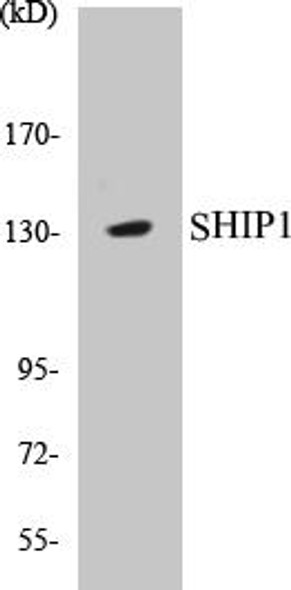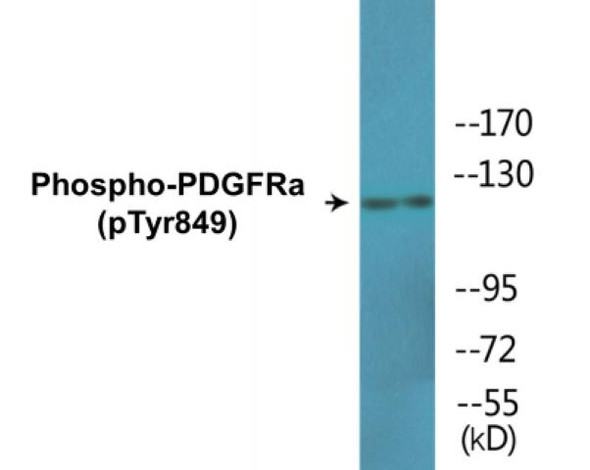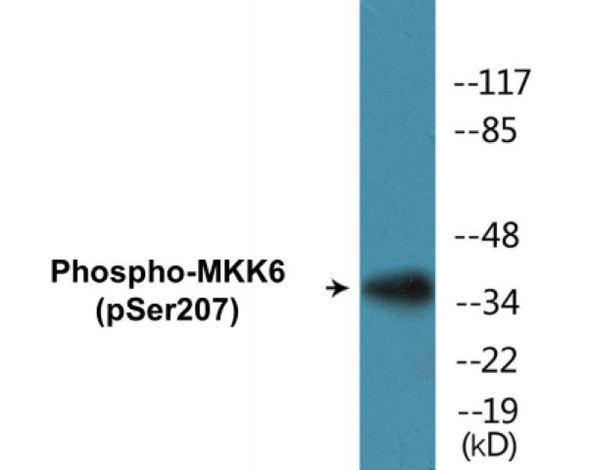Description
SHIP1 (Phospho-Tyr1021)Colorimetric Cell-Based ELISA Kit
The SHIP1 Phospho-Tyr1021 Colorimetric Cell-Based ELISA Kit is a powerful tool for the accurate detection of phosphorylated SHIP1 levels in cell lysates and tissue samples. This kit offers high sensitivity and specificity, allowing researchers to confidently measure SHIP1 activation levels in a variety of experimental settings.SHIP1, a critical regulator of cellular signaling pathways, plays a key role in modulating immune responses, cell survival, and proliferation. Phosphorylation of SHIP1 at Tyr1021 is known to impact its enzymatic activity and downstream signaling events, making it a valuable marker for studying intracellular signaling cascades.
Researchers can utilize the SHIP1 Phospho-Tyr1021 Colorimetric Cell-Based ELISA Kit to investigate the impact of various stimuli on SHIP1 phosphorylation, elucidate its role in disease pathology, and evaluate potential therapeutic interventions targeting this signaling pathway. With its robust performance and broad applicability, this kit is an essential tool for advancing our understanding of SHIP1 function in health and disease.
| Product Name: | SHIP1 (Phospho-Tyr1021)Colorimetric Cell-Based ELISA Kit |
| Product Code: | CBCAB01361 |
| ELISA Type: | Cell-Based |
| Target: | SHIP1 (Phospho-Tyr1021) |
| Reactivity: | Human, Mouse, Rat |
| Dynamic Range: | > 5000 Cells |
| Detection Method: | Colorimetric 450 nm |
| Format: | 2 x 96-Well Microplates |
The SHIP1 (Phospho-Tyr1021) Colorimetric Cell-Based ELISA Kit is a convenient, lysate-free, high throughput and sensitive assay kit that can detect SHIP1 protein phosphorylation and expression profile in cells. The kit can be used for measuring the relative amounts of phosphorylated SHIP1 in cultured cells as well as screening for the effects that various treatments, inhibitors (ie. siRNA or chemicals), or activators have on SHIP1 phosphorylation.
Qualitative determination of SHIP1 (Phospho-Tyr1021) concentration is achieved by an indirect ELISA format. In essence, SHIP1 (Phospho-Tyr1021) is captured by SHIP1 (Phospho-Tyr1021)-specific primary (1ø) antibodies while the HRP-conjugated secondary (2ø) antibodies bind the Fc region of the 1ø antibody. Through this binding, the HRP enzyme conjugated to the 2ø antibody can catalyze a colorimetric reaction upon substrate addition. Due to the qualitative nature of the Cell-Based ELISA, multiple normalization methods are needed:
| 1. | A monoclonal antibody specific for human GAPDH is included to serve as an internal positive control in normalizing the target absorbance values. |
| 2. | Following the colorimetric measurement of HRP activity via substrate addition, the Crystal Violet whole-cell staining method may be used to determine cell density. After staining, the results can be analysed by normalizing the absorbance values to cell amounts, by which the plating difference can be adjusted. |
| Database Information: | Gene ID: 3635, UniProt ID: Q92835, OMIM: 601582, Unigene: Hs.262886/Hs.601911 |
| Gene Symbol: | INPP5D |
| Sub Type: | Phospho |
| UniProt Protein Function: | SHIP: an SH2-containing inositol phosphatase. A hemopoietic-specific phosphatase that regulates cell survival, growth, cell cycle arrest and apoptosis. Hydrolyzes Ins(1,3,4,5)P4 and PtdIns(3,4,5)P3. A cytosolic protein with a SH2 domain in its N-terminus and two NPXY Shc binding motifs at its C-terminus. Upon receptor cross-linking, SHIP is first recruited to the plasma membrane by its SH2, followed by tyrosine phosphorylation on the NPXY motif. Both membrane relocalization and phosphorylation are essential for its regulatory function. Associates with SHC after cytokine stimulation. |
| UniProt Protein Details: | Protein type:Phosphatase, lipid; EC 3.1.3.86; Motility/polarity/chemotaxis Chromosomal Location of Human Ortholog: 2q37.1 Cellular Component: cytoskeleton; cytosol; lipid raft; plasma membrane Molecular Function:inositol-polyphosphate 5-phosphatase activity; protein binding; PTB domain binding; SH3 domain binding Biological Process: apoptosis; blood coagulation; determination of adult life span; immunoglobulin mediated immune response; inositol phosphate metabolic process; leukocyte migration; negative regulation of B cell proliferation; negative regulation of bone resorption; negative regulation of immune response; negative regulation of interleukin-6 biosynthetic process; negative regulation of monocyte differentiation; negative regulation of neutrophil differentiation; negative regulation of osteoclast differentiation; negative regulation of signal transduction; phosphate metabolic process; phosphatidylinositol biosynthetic process; phosphoinositide dephosphorylation; phospholipid metabolic process; positive regulation of apoptosis; positive regulation of B cell differentiation; positive regulation of erythrocyte differentiation; signal transduction; T cell receptor signaling pathway |
| NCBI Summary: | This gene is a member of the inositol polyphosphate-5-phosphatase (INPP5) family and encodes a protein with an N-terminal SH2 domain, an inositol phosphatase domain, and two C-terminal protein interaction domains. Expression of this protein is restricted to hematopoietic cells where its movement from the cytosol to the plasma membrane is mediated by tyrosine phosphorylation. At the plasma membrane, the protein hydrolyzes the 5' phosphate from phosphatidylinositol (3,4,5)-trisphosphate and inositol-1,3,4,5-tetrakisphosphate, thereby affecting multiple signaling pathways. The protein is also partly localized to the nucleus, where it may be involved in nuclear inositol phosphate signaling processes. Overall, the protein functions as a negative regulator of myeloid cell proliferation and survival. Mutations in this gene are associated with defects and cancers of the immune system. Alternative splicing of this gene results in multiple transcript variants. [provided by RefSeq, Feb 2014] |
| UniProt Code: | Q92835 |
| NCBI GenInfo Identifier: | 158564077 |
| NCBI Gene ID: | 3635 |
| NCBI Accession: | Q92835.2 |
| UniProt Secondary Accession: | Q92835,O00145, Q13544, Q13545, Q6P5A4, Q92656, Q9UE80 |
| UniProt Related Accession: | Q92835 |
| Molecular Weight: | 109,294 Da |
| NCBI Full Name: | Phosphatidylinositol 3,4,5-trisphosphate 5-phosphatase 1 |
| NCBI Synonym Full Names: | inositol polyphosphate-5-phosphatase D |
| NCBI Official Symbol: | INPP5D |
| NCBI Official Synonym Symbols: | SHIP; SHIP1; SHIP-1; hp51CN; SIP-145; p150Ship |
| NCBI Protein Information: | phosphatidylinositol 3,4,5-trisphosphate 5-phosphatase 1 |
| UniProt Protein Name: | Phosphatidylinositol 3,4,5-trisphosphate 5-phosphatase 1 |
| UniProt Synonym Protein Names: | Inositol polyphosphate-5-phosphatase of 145 kDa; SIP-145; SH2 domain-containing inositol 5'-phosphatase 1; SH2 domain-containing inositol phosphatase 1; SHIP-1; p150Ship; hp51CN |
| Protein Family: | Phosphatidylinositol 3,4,5-trisphosphate 5-phosphatase |
| UniProt Gene Name: | INPP5D |
| UniProt Entry Name: | SHIP1_HUMAN |
| Component | Quantity |
| 96-Well Cell Culture Clear-Bottom Microplate | 2 plates |
| 10X TBS | 24 mL |
| Quenching Buffer | 24 mL |
| Blocking Buffer | 50 mL |
| 15X Wash Buffer | 50 mL |
| Primary Antibody Diluent | 12 mL |
| 100x Anti-Phospho Target Antibody | 60 µL |
| 100x Anti-Target Antibody | 60 µL |
| Anti-GAPDH Antibody | 60 µL |
| HRP-Conjugated Anti-Rabbit IgG Antibody | 12 mL |
| HRP-Conjugated Anti-Mouse IgG Antibody | 12 mL |
| SDS Solution | 12 mL |
| Stop Solution | 24 mL |
| Ready-to-Use Substrate | 12 mL |
| Crystal Violet Solution | 12 mL |
| Adhesive Plate Seals | 2 seals |
The following materials and/or equipment are NOT provided in this kit but are necessary to successfully conduct the experiment:
- Microplate reader able to measure absorbance at 450 nm and/or 595 nm for Crystal Violet Cell Staining (Optional)
- Micropipettes with capability of measuring volumes ranging from 1 µL to 1 ml
- 37% formaldehyde (Sigma Cat# F-8775) or formaldehyde from other sources
- Squirt bottle, manifold dispenser, multichannel pipette reservoir or automated microplate washer
- Graph paper or computer software capable of generating or displaying logarithmic functions
- Absorbent papers or vacuum aspirator
- Test tubes or microfuge tubes capable of storing ≥1 ml
- Poly-L-Lysine (Sigma Cat# P4832 for suspension cells)
- Orbital shaker (optional)
- Deionized or sterile water
*Note: Protocols are specific to each batch/lot. For the correct instructions please follow the protocol included in your kit.
| Step | Procedure |
| 1. | Seed 200 µL of 20,000 adherent cells in culture medium in each well of a 96-well plate. The plates included in the kit are sterile and treated for cell culture. For suspension cells and loosely attached cells, coat the plates with 100 µL of 10 µg/ml Poly-L-Lysine (not included) to each well of a 96-well plate for 30 minutes at 37 °C prior to adding cells. |
| 2. | Incubate the cells for overnight at 37 °C, 5% CO2. |
| 3. | Treat the cells as desired. |
| 4. | Remove the cell culture medium and rinse with 200 µL of 1x TBS, twice. |
| 5. | Fix the cells by incubating with 100 µL of Fixing Solution for 20 minutes at room temperature. The 4% formaldehyde is used for adherent cells and 8% formaldehyde is used for suspension cells and loosely attached cells. |
| 6. | Remove the Fixing Solution and wash the plate 3 times with 200 µL 1x Wash Buffer for five minutes each time with gentle shaking on the orbital shaker. The plate can be stored at 4 °C for a week. |
| 7. | Add 100 µL of Quenching Buffer and incubate for 20 minutes at room temperature. |
| 8. | Wash the plate 3 times with 1x Wash Buffer for 5 minutes each time. |
| 9. | Add 200 µL of Blocking Buffer and incubate for 1 hour at room temperature. |
| 10. | Wash 3 times with 200 µL of 1x Wash Buffer for 5 minutes each time. |
| 11. | Add 50 µL of 1x primary antibodies Anti-SHIP1 (Phospho-Tyr1021) Antibody, Anti-SHIP1 Antibody and/or Anti-GAPDH Antibody) to the corresponding wells, cover with Parafilm and incubate for 16 hours (overnight) at 4 °C. If the target expression is known to be high, incubate for 2 hours at room temperature. |
| 12. | Wash 3 times with 200 µL of 1x Wash Buffer for 5 minutes each time. |
| 13. | Add 50 µL of 1x secondary antibodies (HRP-Conjugated AntiRabbit IgG Antibody or HRP-Conjugated Anti-Mouse IgG Antibody) to corresponding wells and incubate for 1.5 hours at room temperature. |
| 14. | Wash 3 times with 200 µL of 1x Wash Buffer for 5 minutes each time. |
| 15. | Add 50 µL of Ready-to-Use Substrate to each well and incubate for 30 minutes at room temperature in the dark. |
| 16. | Add 50 µL of Stop Solution to each well and read OD at 450 nm immediately using the microplate reader. |
(Additional Crystal Violet staining may be performed if desired – details of this may be found in the kit technical manual.)






